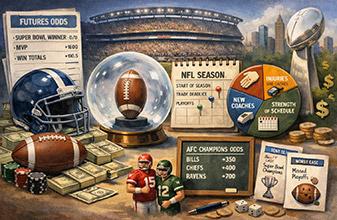ROI and Money Management

King Yao is the author of Weighing the Odds in Hold‘em Poker, and Weighing the Odds in Sports Betting. He uses his experience from making millions in financial derivative markets and translates it into gambling. Since he left his trading position in 2000, he has been playing poker and betting on sports. He travels to Las Vegas frequently, especially during football season.
Let’s discuss basic principles of sports betting. All sports bettors should know the information below. All other types of casino advantage players, including blackjack players of all skill sets, which includes card counters, should have good working knowledge of Expected Value as well. You should not be betting online or anywhere else without this fundamental knowledge.
ROI is the acronym for Return on Investment and is expressed in percentage. ROI uses two variables: return and investment. Return is the profit on the investment. Investment is the funds that you put up to make the wager(s). ROI does not take into account the time it takes for a wager to be completed. It is possible for two investments to have the same ROI, but one investment to be superior because it takes less time to complete. The formula is:
ROI = Profit / Investment
Example:
You make 500 bets during the season. Each bet is on point spreads laying -110 juice. You risk $220 to win $200 on each bet. Five hundred bets at $220 per bet means the total investment is $110,000. At the end of the year, your net profit is $3,300. Your ROI is:
ROI
= $3,300 / $110,000
= 3.0%
Some people use ROE (return on equity) or ROR (return on risk) to mean the same as ROI. A higher ROI does not necessarily mean superior performance. A bettor with a high ROI may be passing on positive-EV bets with relatively low ROI. This bettor keeps his ROI high at the expense of net profit. ROI should be viewed in conjunction with overall profits in order to see the big picture.
Expected ROI
Instead of using the known profits for the return, Expected ROI uses expected profits in the numerator. The formula is:
Expected ROI = Expected Profit / Investment
Here is an example of using expected ROI to calculate expected profits. You find a money line on the Yankees at -150 against the Angels. You bet $1,500 to win $1,000 on the Yankees. At game time, a good player is scratched from the Angel lineup and the mid-market line moves to Yankees -180. Assuming -180 is now the fair line, the EV is:
EV
= (180/280) x $1,000 + (100/280) x -$1,500
= +$107.14
The expected profit is $107.14, and the total investment was $1,500. The expected ROI on this game at game time is:
Expected ROI
= $107.14 / $1,500
= 7.14%
Money Management
There are two kinds of money management: smart and stupid. The smart kind of money management deals with bet sizing to reduce the probability of going bankrupt and diversifying risk. The stupid kind of money management deals with trying to turn combinations of uncorrelated negative-EV bets into a positive-EV portfolio. Unfortunately, these two concepts get confused by gamblers because both are called “money management’.
Smart money management
How much should you bet? You have to make your own decisions on how much to bet. Your personal risk preference is just that: personal. No one can tell you perfectly how much to bet given a certain bankroll unless you tell them the exact level of your personal risk preferences. There are good tools, such as the Kelly Criterion, that will help answer the right amount to bet given a certain bankroll, but these tools need your input on the amount of risk you are willing to take, as well as the expected edge of each bet. Be true to yourself and your own risk preference and take responsibility for your bets, whether they win or lose.
Here are some general conservative steps you can take to figure out how much to bet:
Figure out your sports-betting bankroll. This is the money that can be dedicated to betting; if it is lost you will be sad, but it won’t eat away at you or at your family’s living expenses.
For most wagers, bet only 1% of your sports-betting bankroll. This should allow the possibility of a bad losing streak to occur without crippling your bankroll. Make sure that you are comfortable with the amount that 1% represents. If losing that amount makes you sick to your stomach, then it is too much to bet. If winning that amount does nothing for you, then maybe your bankroll is set too low.
Save the 2% bets for the best bets, the ones that have the most edge. It is often difficult to gauge the exact edge you have in sports betting. It is possible you are wrong or unlucky. Do not bet a huge percentage of your bankroll on any one bet in case you are wrong or make a mistake. Betting too much and losing can be a big detriment as it can cloud your thinking on future bets.
You can risk more if the payoff schedule has little downside. For example, middling a game has little downside if equal amounts are bet on both sides. The two risks in the game are negatively correlated, so the true risk is much smaller than the total funds used for the bets.
Betting these low percentages on individual games will mean a slow bankroll growth. But it will also minimize the risk of a disaster.
Casual bettors can afford to bet a higher percentage than professional bettors because casual bettors have other income sources that professional bettors may not have.
Stupid money management
Trying to turn bad bets into a good portfolio does not work. There are no money management schemes that can turn a combination of negative-EV bets into a positive-EV portfolio. Beginning gamblers often think up their own version of the Martingale system. I thought up this system myself when I first got out of college; but lucky for me, I never put it into play. The classic Martingale system is doubling your bet size after losing. You bet a small unit on a bet that pays close to even money. If you win, you repeat the bet. If you lose, you double the bet. The doubling allows you to win one unit when the win finally does come. To illustrate the idea, let’s use hypothetical games at even money juice but with true win rates of 48% for each game.
Rule if a bet is a winner: go back to the bet size in bet 1
Rule if a bet is a loser: bet twice as big as the previous bet
Bet 1: $10 to win $10
Bet 2: $20 to win $20
Bet 3: $40 to win $40
Bet 4: $80 to win $80
Bet 5: $160 to win $160
Etc.
The gambler thinks that with this progression of bets, he is surely going to win sooner or later and eventually win the $10 in his first bet. He thinks that if he can repeat it forever, he will become rich!
There are two requirements:
- The sportsbook allows infinitely large bets
- You have a bankroll of infinite size
No one can satisfy these two requirements, including Bill Gates and the biggest casinos in the world. Instead, what will happen if the gambler continues to play this progression is that the gambler will eventually hit one of the two limits: either his bankroll will run out or the casino will no longer accept his wager due to its size.
Since he has negative EV on each bet (remember we pegged each game as having a 48% chance of winning), the sum of the bets has negative EV.
Let’s say you have $2,550 in your bankroll, and you start off making $10 bets with the odds described above. It would take only 8 losing bets for you to go bankrupt ($10, $20, $40, $80, $160, $320, $640 and $1,280). The chance of you going bankrupt is small; it is only 0.5346% (52% to the 8th power) or about 1 in 200. Even though it is likely you will escape and not lose eight straight bets, the big loss that occurs when the unlikely event happens will crush you. You are not being paid appropriately for the risk you are taking. If the individual bets are negative EV, then the Martingale is a negative-EV system. Here is the calculation using the variables listed in this section.
EV of the Martingale system
= (0.5346% x -$2,550) + (99.4654% x $10)
= -$3.69
You must look for positive-EV bets. Money-management systems that turn negative-EV bets into positive-EV portfolios when the bets are not correlated do not exist.
This is part of an occasional series of articles.
Excerpted with permission from the e-book version of Weighing the Odds in Sports Betting by King Yao, edited for this format.











Please log in or register to leave a comment